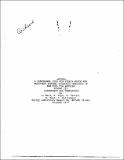WOSUB : a subchannel code for steady-state and transient thermal-hydraulic analysis of BWR fuel pin bundles. Volume III. Assessment and Comparison
Author(s)
Wolf, Lothar; Levin, A.; Faya, A.; Boyd, W.; Guillebaud, Louis Jean Marie
DownloadMIT-EL-78-025-05699880.pdf (9.788Mb)
Metadata
Show full item recordAbstract
The WOSUB-codes are spin-offs and extensions of the
MATTEO-code [1]. The series of three reports describe WOSUB-I
and WOSUB-II in their respective status as of July 31, 1977.
This report is the third in a series of three, the
first of which [2] contains all the information about the
models, solution methods and constitutive equations and the
second [3] being the user's manual of the code.
This report summarizes the assessment of the WOSUB-
code against experiments and compares its results with the
results of other subchannel codes. The following experiments
are used for the purpose of the assessment of the code under
steady-state conditions:
1) 9-rod GE-tests with radially uniform and non-
uniform peaking factor patterns.
2) 16-rod Columbia tests with slight power tilts.
3) Planned 9-rod Swedish tests with very strong
power tilts.
4) Actually performed 9-rod Swedish tests with
power tilt.
5) 9-rod GE-CHF experiments.
The comparison with these data shows that WOSUB is capable of
predicting the lower-than-average behavior of the corner sub-
channel and the higher-than-average behavior of the center
subchannel for both quality and mass flux. None of the other
well-known subchannel codes is indeed capable of specifically
predicting the correct corner subchannel behavior. These codes
seem to inherently suffer from major deficiencies associated
with their incorporated mixing models. Therefore, it is con-
cluded that only improved models for the description of two-
phase flow phenomena are capable of handling these situations
and that the vapor drift flux model together with the vapor
diffusion model as incorporated into WOSUB is doing a good job.
The fact that WOSUB does not perfectly match the experimental
results over the whole spectrum of experimental evidence can
be attributed to the vapor diffusion model which was originally
fitted to air-water test results in a geometry consisting of
two subchannels only. Obviously, this geometry leads to over-
emphasizing the importance of the vapor diffusion as compared
to what actually happens in a multi-rod geometry.
WOSUB gives the user the option of calculating the
critical power as a function of the boiling length - a concept
which is especially useful to easily account for axially nonuniform power profiles and which closely resembles the
procedure now used by GE. Furthermore, the code determines
four heat transfer coefficients around the circumference of the
fuel pin, thus giving the user the possibility of selecting
the minimal one for the purpose of hot spot calculations.
Overall, the assessment and comparison presented in
this volume show that the WOSUB-code has to be considered a
valuable tool for BWR bundle and PWR test bundle analysis with
a potential for further improvements.
The commonly used concept of power-to-flow ratio
fails to explain most of the test data used for comparison in
this report.
The WOSUB-code is still in the stage of evolutionary
development. In this context, the results presented in this
present report have to be considered preliminary. They
reflect the development as of July 1977.
Date issued
1977-10Publisher
MIT Energy Laboratory
Other identifiers
05699880
Series/Report no.
MIT-EL78-025
Keywords
Boiling water reactors., Nuclear fuel elements |x Computer programs.
Collections
The following license files are associated with this item: